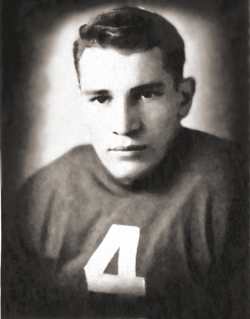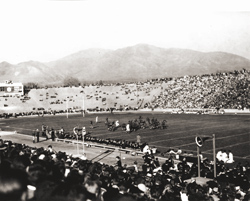
|
|
About Continuum Advertising Advisory Committee Archives Contact Us Continuum Home Faculty/Staff Subscribe related websites Alumni Association Marketing & Communications University of Utah Home |

ALUM PROFILEThe Forever FanJoseph B. Wirthlin was the quintessential Ute football aficionado.By Dale J. Neilson  Historical photos courtesy Special Collections, Marriott Library, The University of Utah
Sports fans diligently pursuing up-close-and-personal relationships with their favorite teams is nothing new. Socializing with athletes and coaches can give one a sense of inclusion—and, if you’re a former football star, a chance to revisit some of the highlights of your career, and to give back to the team you love. The late Joseph B. Wirthlin BA’41 developed such a relationship with the University of Utah’s football team, which intensified in 2003 when the 1936-38 star Ute halfback met rookie U of U coach Urban Meyer. “[The relationship] really got a lot of traction when [Meyer] got here,” says Crimson Club chair Blake Strong. When the coach learned that an apostle of the Church of Jesus Christ of Latter-day Saints had once played for the Utes, “He wanted to know Joseph Wirthlin. “Urban Meyer had a lot of respect for him and the church,” continues Strong. “They became instant friends, and [the coach] brought him close” to the program. Meyer recruited Wirthlin to speak to the team about his love for U of U football, as well as the importance of honesty, work ethic, and teamwork. A U of U graduate in business, Wirthlin began offering prayers at team dinners and personally encouraging players at football practices. “He would always talk about integrity on and off the field,” says his son, Joseph B. Wirthlin, Jr. “How he played was the basis for the rest of his life.” The process not only precipitated a natural friendship between Wirthlin, Meyer, and then-assistant coach Kyle Whittingham, but it also saw Wirthlin inadvertently grow into a unique position as a type of spiritual leader. “In recent years, he was something of a self-appointed chaplain to the U team,” LDS Church President Thomas S. Monson BS’48 recalled during the live TV broadcast of Wirthlin’s funeral on December 5, 2008. “He was respected by coaches, players, and fans alike.” Business and the Business of Football Wirthlin with U of U students Caitlin McDonald and Clay Peterson, both President’s Office interns, in the President’s Suite at Rice-Eccles Stadium during the 2008 Utah-BYU game, the last game he was able to attend.
Wirthlin began a lifelong devotion to the Utes while just a child. Eighty-plus years later, in 2008, he missed only two of the team’s games before he died on December 1 at age 91. Wirthlin preferred to sit in the U of U student section, which is close to the field. “He loved to hear the pads crack,” says Strong. His wife, Elisa, was also a football fan and faithfully attended games with him. “[Elisa] had a great friendship with Shelley Meyer (wife of Urban), who just loved her,” says Joe, Jr. The Wirthlins sat in the student section right behind their friend, and “Shelley always turned around after a touchdown. Once she almost knocked [Dad] over with a high-five due to her enthusiasm.” After three years of playing football at the U, Wirthlin served an LDS mission to Germany, Austria, and Switzerland. When he returned home, his management skills were needed in the family business, Wirthlin’s Meating Place. As a result, he didn’t have much time for football. The coach at the time, Ike Armstrong, very likely missed his halfback, nicknamed “Speedy” Wirthlin. As a 19-year-old U of U sophomore, “Dad could run the hundred [yards] in just under 10 [seconds] flat,” relates Joe, Jr. Besides Wirthlin’s speed, his athletic build (5’10”, 175 lbs.) also likely assisted him in running through or away from would-be tacklers. Although his college career was foreshortened, Wirthlin applied the lessons learned from football for the rest of his life. “He would always talk about his U of U coach, Ike Armstrong, and the things he learned as a young man: character, strength, and conviction,” recalls Joe, Jr. Talking Religion and the Religion of FootballMeyer and Wirthlin became such good friends that they and their wives often dined together. Some discussions may have been filled with more questions than answers, according to Strong, who was occasionally among the dinner guests. Wirthlin generally wanted to talk football, and Meyer was interested in religion, so they quizzed each other. “It [would go] all night at the Wirthlins’,” Strong recalls. “It was an exchange of ideas of what each cared most about,” says Joe, Jr. “[My father] always respected somebody else’s opinion.” Wirthlin was happy to engage in a discussion about LDS beliefs, and Meyer reciprocated with Football 101. Lasting Legacy of the Forever Fan Rice Stadium, circa the 1930s.
Fast-forward to New Orleans, January 2, 2009. As Ute players take the field at the Sugar Bowl, fans in the stands—and millions watching from home—note the letters JBW inscribed on the back of each player’s helmet. The initializing was Whittingham’s idea, says Joe, Jr. “Dad didn’t like to be in the limelight.” Even so, he says, “It’s a fitting tribute.” And many of the players felt privileged to wear the initials of Wirthlin, regarded as a football program icon by many, including Meyer and successor Whittingham, who remained close friends with Wirthlin until his passing. “Kyle picked up right where Urban left off,” says Strong, with Wirthlin continuing to attend dinners and sit on the team bench at the spring game. “We just enjoyed having him around the team,” says Whittingham, who describes Wirthlin as a natural mentor. “He was very gentle, kind, and had a grandfather-type of demeanor.… ‘Genuine’ is the word I would use for him.” What Meyer started in public relations and good football, Whittingham finished, says Strong. “Before [Meyer’s tenure], Elder Wirthlin was a real loyal Utah supporter.” But, he says, during the last five to seven years of his life, Wirthlin really experienced the excitement and depth of U of U football, its fans, and what it has and can further become. Wirthlin’s No. 4 football jersey was retired by the University in 2003, when he was given a replica. “It was later framed and, for a time, hung in his office at the Church Administration Building,” LDS Church President Monson recalled at the apostle’s funeral. Wirthlin was also recognized in 2006 with the Distinguished Alumnus Award, the Alumni Association’s highest honor. Shortly after his death, the Joseph B. Wirthlin Memorial Scholarship was created, Strong says, “to have an ongoing legacy forever tying him to the football program. It’s to honor him and Utah football at the same time.” Joe, Jr., says his father would be honored with the namesake scholarship, “but a little embarrassed, too.” The former Utah star and forever fan would probably rather talk football. —Dale J. Neilson BS’94 is a Salt Lake City-based freelance writer. The U’s Athletics Department is establishing the Joseph B. Wirthlin Scholarship with the support of the Wirthlin family, the University of Utah, and the Church of Jesus Christ of Latter-day Saints. Initial contributors to the program include current coach Kyle Whittingham and former coach Urban Meyer. For more information, or to make a contribution, contact the Utah Athletics Departments at (801) 587-8837.
|